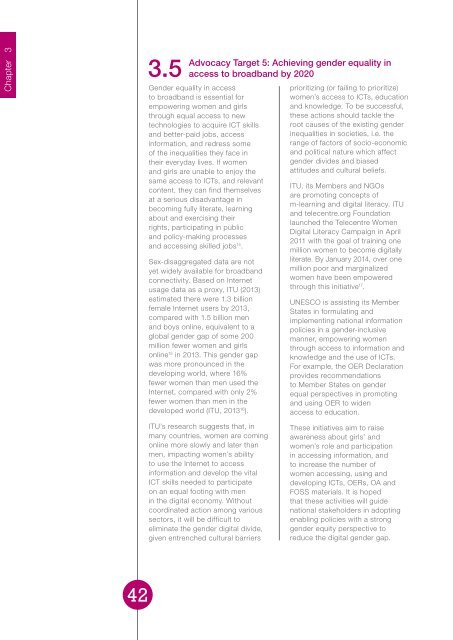DI8xz
DI8xz
DI8xz
Create successful ePaper yourself
Turn your PDF publications into a flip-book with our unique Google optimized e-Paper software.
Chapter 33.5Advocacy Target 5: Achieving gender equality inaccess to broadband by 2020Gender equality in accessto broadband is essential forempowering women and girlsthrough equal access to newtechnologies to acquire ICT skillsand better-paid jobs, accessinformation, and redress someof the inequalities they face intheir everyday lives. If womenand girls are unable to enjoy thesame access to ICTs, and relevantcontent, they can find themselvesat a serious disadvantage inbecoming fully literate, learningabout and exercising theirrights, participating in publicand policy-making processesand accessing skilled jobs 14 .Sex-disaggregated data are notyet widely available for broadbandconnectivity. Based on Internetusage data as a proxy, ITU (2013)estimated there were 1.3 billionfemale Internet users by 2013,compared with 1.5 billion menand boys online, equivalent to aglobal gender gap of some 200million fewer women and girlsonline 15 in 2013. This gender gapwas more pronounced in thedeveloping world, where 16%fewer women than men used theInternet, compared with only 2%fewer women than men in thedeveloped world (ITU, 2013 16 ).prioritizing (or failing to prioritize)women’s access to ICTs, educationand knowledge. To be successful,these actions should tackle theroot causes of the existing genderinequalities in societies, i.e. therange of factors of socio-economicand political nature which affectgender divides and biasedattitudes and cultural beliefs.ITU, its Members and NGOsare promoting concepts ofm-learning and digital literacy. ITUand telecentre.org Foundationlaunched the Telecentre WomenDigital Literacy Campaign in April2011 with the goal of training onemillion women to become digitallyliterate. By January 2014, over onemillion poor and marginalizedwomen have been empoweredthrough this initiative 17 .UNESCO is assisting its MemberStates in formulating andimplementing national informationpolicies in a gender-inclusivemanner, empowering womenthrough access to information andknowledge and the use of ICTs.For example, the OER Declarationprovides recommendationsto Member States on genderequal perspectives in promotingand using OER to widenaccess to education.ITU’s research suggests that, inmany countries, women are comingonline more slowly and later thanmen, impacting women’s abilityto use the Internet to accessinformation and develop the vitalICT skills needed to participateon an equal footing with menin the digital economy. Withoutcoordinated action among varioussectors, it will be difficult toeliminate the gender digital divide,given entrenched cultural barriersThese initiatives aim to raiseawareness about girls’ andwomen’s role and participationin accessing information, andto increase the number ofwomen accessing, using anddeveloping ICTs, OERs, OA andFOSS materials. It is hopedthat these activities will guidenational stakeholders in adoptingenabling policies with a stronggender equity perspective toreduce the digital gender gap.42


